


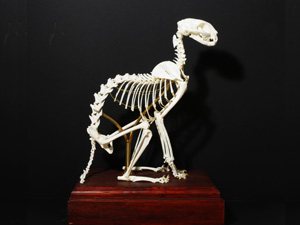
ネコ
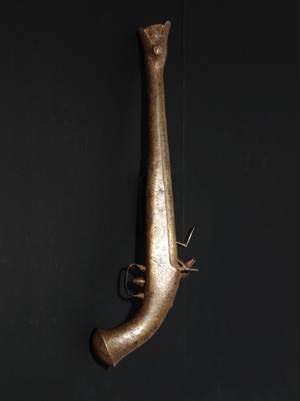
オスマン帝国の銃
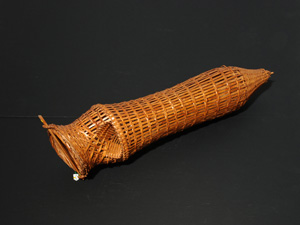
ラオスの漁具
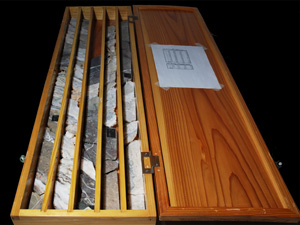
鹿児島県菱刈鉱山産ボーリングコア
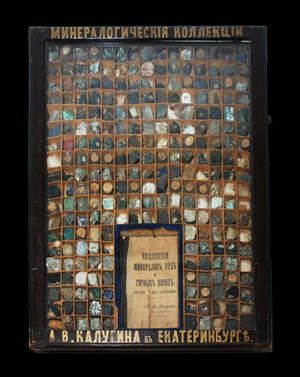
ロシアの鉱物標本
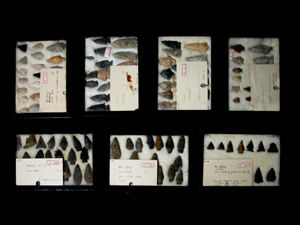
石鏃と尖頭器
 展示標本 (2010.2.1〜2010.7.30)
展示標本 (2010.2.1〜2010.7.30)小ケース1: ネコ
市街地で動物の死体を見つけることは珍しくない。東京でハトやカラスと並んでよく収集されるのが、ネコだろう。これは都内で拾われた死体のネコから作られた全身骨格である。体重5キロ、全長800ミリほどの雌。ごく普通の動物ではあるが、組み上げられた標本からは、ネコ類特有の機能的な形を見ることができる。ネコの敏捷さや柔軟さは、こうした細身の骨格の機能形態によって、実現しているのである。(H.E.)
domesticated cat ( Felis catus )
We often find the dead bodies of animals in city areas. The dead bodies of cat have been collected as well as pigeons and crows in Tokyo. It is the whole skeleton specimen from the dead body of the cat found in Tokyo. This female was approximately 5 kg in body weight and 800 mm in total body length. As the cat is one of the most common species in city area, we can observe the adaptational form peculiar to the cats from the mounted skeleton. The agility and suppleness of the body are functional-morphologically supported by the slender bones in the cat.
小ケース2: オスマン帝国の銃
オスマン帝国時代、17世紀の中近東で使用されていた銃。2008年に総合研究博物館に寄贈された。鶏頭部に取り付けた石器(火打ち石)を鋼鉄板に打ち付けて発火させる。いわゆるフリントロック銃の一つである。16世紀に出現し、一部では20世紀にいたるまで用いられた。鎖国中の日本で火縄銃が使用されていた頃、西側世界ではこの種の火器が発達し帝国の躍進をうながした。(Y.N.)
Flintlock of the Ottoman period
This firearm, recently donated to the University Museum, is derived from the 17th century, the Ottoman period of the Middle East. It is a type of flintlock, with the flint that was struck on a piece of steel to ignite fire. The flintlock originated in 16th century Europe, and was in use until the 20th century. While the matchlock was prevalent during the Edo period of Japan, this and other new types of guns were developed in the West, leading to the rise of empires with significant military power.
小ケース3: ラオスの漁具
河川で実際に使用されていたこの漁具は、生態人類学者の渡辺仁氏が1975年にラオスで行った民族調査の際に収集され、その後寄贈された。かごの一端から入る魚が閉じ込められるしくみである。ウケと呼ばれるこの種の漁具は東南アジアだけでなく、日本でも広く報告されている。ウケの形態やサイズは多様であるが、展示品のように細長い形態は、うなぎ用といわれている。狭い空間にもぐりこむうなぎの習性を利用しているのである。(S.K.)
Fish trap in Laos
This fish trap, actually used in rivers in Laos, was collected by Prof. Hitoshi Watanabe, an ecological anthropologist, who visited Laos in 1975 for ethnological fieldwork. The piece was subsequently donated to the museum. The basket traps fishes that enter through the mouth at one end. This type of fish trap, called “Uke”, is known to be widely used in southeast Asia as well as in Japan. Among the diverse shapes and sizes of Uke, the narrow cylindrical form like the exhibit is designed to trap eels, taking advantage of their nature to favor narrow spaces.
中ケース1: 鹿児島県菱刈鉱山産ボーリングコア
菱刈鉱山は1981年に発見された世界でも最高の品位(含有率)を誇る金鉱床を有する鉱山である。世界で採掘されている多くの金鉱山の鉱石の品位は数グラム/トン程度であるのに比べて、菱刈鉱山の鉱石は発見時には平均80グラム/トンであった。さらに、最も品位の高い部分では5キログラム/トンを超えるような驚異的な値を示す。このボーリングコアの標本は、1993年頃に住友金属鉱山から寄贈されたものであるとされるが、異常とも言えるほどの金の濃集過程を研究するためにも欠かすことの出来ない標本である。(H.M.)
Boring-core samples from the Hishikari gold mine, Kagoshima prefecture
Hishikari gold mine, discovered in 1981, is among the world’s richest gold mines in terms of the high-grade gold concentration. While most gold mines typically have ore holding several grams of Au per ton, the ore in the Hishikari gold mine contain an average of 80 grams of Au per ton at an early stage of its development. The highest concentration of Au recorded in the mine is more than 5kg per ton, which is surprisingly high. The rock samples displayed here were excavated as boring cores from the mine before being donated by Sumitomo metal mining Co., LTD. to the UMUT probably in 1993. These samples are considered indispensably important for understanding the origin and the evolution of epithermal vein-type deposits.
中ケース2: ロシアの鉱物標本
明治29年に東京大学で鉱物学の教授となった神保小虎(じんぼうことら)が、ロシアを訪れた際に持ち帰ったと言われているが、詳細な来歴は不明。(H.M.)
Mineral collection from Russia
This mineral sample collection is believed to be brought back from Russia by Prof. Kotora Jinbou, who became a professor of mineralogy of the University of Tokyo in 1896.
中ケース3: 石鏃と尖頭器
東京大学、初代動物学教授のE. S. モースは貝類の専門家であったが、1877年に大森貝塚を発掘し、日本で初めて科学的な考古学調査を実践した。モースは1879年に帰米するが、大学が展示場をもつ重要性を説き、神田一ツ橋に「理学部博物場」が設立された。ここに展示した、黒枠のガラス標本箱と石器は、モースの計らいにより、「博物場」陳列のために米国ピーボディ博物館から寄贈されたものとされている。同様のものが200箱ほど現存している。(G.S.)
Arrowheads and spearhead
E. S. Morse, the first professor of zoology at the University of Tokyo, was a specialist of brachiopods, but is also well known for conducting the first scientific excavation in Japan at the Omori shell mounds. Morse returned to the U.S. in 1879, but had strongly recommended that the University found a museum, which was realized as the Science Museum at Kanda. The materials exhibited here are examples of prehistoric implements, which are thought to be those donated to the University of Tokyo, in the 1880s, through Morse's efforts.
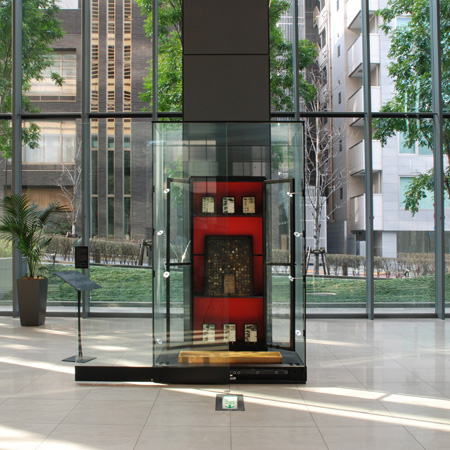
赤坂インターシティのエントランスロビーに設営されたモバイルミュージアム
解説文執筆
諏訪 元 (本館教授、形態人類学) Gen Suwa (Professor)
西秋 良宏 (本館教授、先史考古学) Yoahihiro Nishiaki (Professor)
遠藤 秀紀 (本館教授、比較形態学、遺体科学) Hideki Endo (Professor)
宮本 英昭 (本館准教授、固体惑星科学) Hideaki Miyamoto (Associate Professor)
写真撮影
松本 文夫 (本館特任准教授) Fumio Matsumoto (Affiliate associate professor)
展示期間別の標本解説
2007年1月〜2007年7月
2007年7月〜2008年2月
2008年2月〜2008年8月
2008年8月〜2009年2月
2009年2月〜2009年7月
2009年8月〜2010年1月
2010年2月〜2010年7月
2010年8月〜2011年1月
2011年1月〜2011年7月
2011年8月〜2012年1月
2012年1月〜2012年7月
2012年8月〜2013年2月
2013年2月〜2013年8月
2013年8月〜2014年1月
2014年2月〜2014年11月
2014年11月〜2015年7月
2015年8月〜2016年1月
2016年2月〜2016年7月
今までのトップページの連続スライドショー
興和不動産本社におけるモバイルミュージアム(非公開)
ページの先頭に戻る